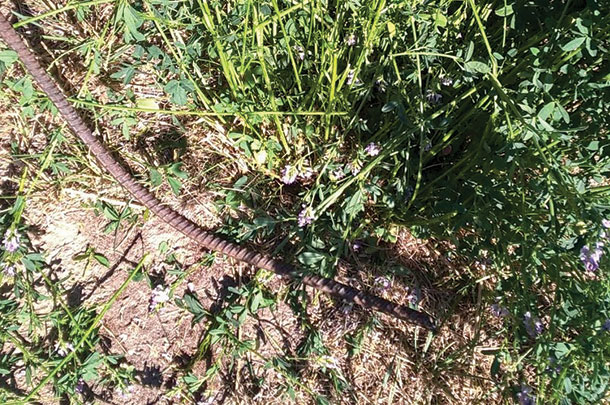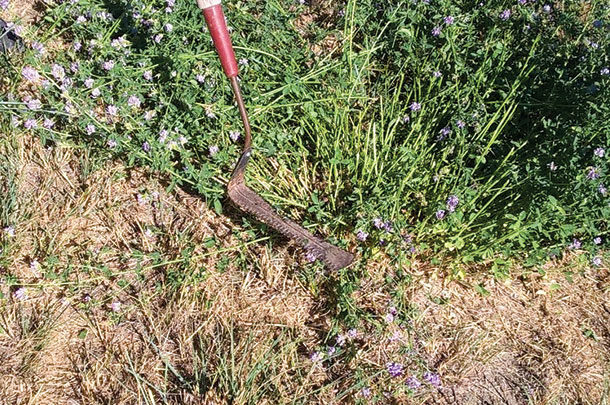In this condition, the knotters would tie correctly most of the time but would fail to tie enough bales so that the fail rate was not acceptable.
To correct this situation, each part of each knotter had to be adjusted to compensate for normal wear. Note that the common novice mistake is to use too much spring tension, which will cause a mistie as easily as too little tension. Adjustment can compensate for wear up to a certain point, and then it’s time to replace parts.
For example, a dull knife that cuts the twine after the knot is tied will function reliably for a very long time, but if the knotter frame is moving in and out of home position by three-quarters of an inch each time the needles bring the twine through the knotter to tie off the current bale and start the next one, the twine will move away from the dull knife rather than be cleanly cut.
To correct either problem will most likely solve the issue, but to understand the cause of the mistie and correct both glitches will correct the problem for a much longer time. Little things add up and left unchecked, they can lead to disasters.
The old sickle bar and reel type swathers let you know when the cutter bar needed attention by scalping the alfalfa rather than cutting at the area of the sickle that was broken. There was some operator leeway as to when you actually had to stop and repair the sickle or guards.
Often dirt from a gopher mound would foul the bar and then clear by itself if you just kept going a little farther. Anything less than stopping as soon as a broken sickle section or guard was noticed, or a plugged spot occurred, would mean leaving a ragged trail through the hay field where the forage had not been properly cut.
The current rotary head swathers have eliminated most of these problems; however, you must realize that if you strike a standing alfalfa stem hard and fast enough with a piece of two-by-four lumber, you can still sever that stem. The idea is to cleanly cut the plants. This works best with a cutting tool that is relatively sharp.
Someone needs to look at the cutting edges of the rotary swather headers to observe whether a sharp or blunt edge meets the hay.
A change was made to narrower swather headers in the Columbia Basin a while back. The wider headers, even feeding the widest conditioners available, left the edge of the windrow thicker than the center. That meant more time to dry the hay, which meant more sun bleaching and more time for rain to spoil the crop.
The narrower headers left the windrow of even thickness, for faster, more uniform drying. The faster drying time meant that even with it taking longer to cut the hay with the smaller header, the hay was ready to bale faster.
Some of the reel and sickle bar swathers had a means to adjust the reel speed. If the hay was lodged, the reel could be set to turn faster than the ground speed of the swather.
This, plus an operator with the patience to do it, would lift most lodged hay and cut it almost as well as if it had been standing up straight. Again, fine tuning to fit the conditions and operator patience to do the job right alleviated the problem.
Things as mundane as a low tire on the gauge wheel on rakes can change raking from rolling over only the current cutting, to adding dirt and debris to the crop. I found a hay grower in Nevada upset because one of his helpers had set the rakes up with different-sized gauge wheels.
Dust and dirt added to hay in the field shows up as a higher ash percentage on the lab results, plus raising the near infrared reflectance spectroscopy (NIR) reading for neutral detergent fiber, which reduces both the RFV (relative feed value) and RFQ (relative feed quality). This means the hay is worth less money.
 Forty years ago some hay buyers in Idaho went first to the growers (who they knew did not even own a rake) to buy their hay; they sought out unraked hay because it was always cleaner than even the most meticulously raked hay.
Forty years ago some hay buyers in Idaho went first to the growers (who they knew did not even own a rake) to buy their hay; they sought out unraked hay because it was always cleaner than even the most meticulously raked hay.
Timing can be everything. Standard procedure in some areas is to use a “fluffer” on the perimeter windrows that have been run over in places by the swather as it turns around.
Properly used, a fluffer will shake loose that portion of the windrow with the wheel tracks on it, so that it can dry thoroughly rather than make a wet slug inside the bale. Note that a wet slug can be anything from annoying to the cause of a haystack fire.
Fluffing needs to be done soon enough after the hay is cut so the fluffing process does not separate the leaf from the stem on alfalfa hay. Fluffers are also used to speed the drying of timothy and other grass hays to minimize sun bleaching.
Fully cured alfalfa in the windrow with just the right amount of dew moisture is still the king of visual quality for alfalfa hay. Proper moisture at baling and proper stage of maturity at cutting remain the two keys to high-quality alfalfa. Anything that fouls either of these will drastically diminish the feed and monetary value of the crop.
While the dews and the rain cannot be controlled, creature comforts for the operator can. An operator’s seat that fits the operator will make for more hours in the field, rather than the machine retiring early because the operator’s back is sore. Some operators may have a hard time reaching the pedals.
With my frame, I have a hard time getting space for my legs, knees and feet. Within reason, it’s money well spent to keep a machine comfortable for the person who will run it hours on end through harvest. Manufacturers claim the ergonomics of their offerings will fit 98 percent of the general population.
When (not if) you get someone outside this fabled number, realize that it doesn’t take a rocket scientist to raise or lower a seat.
Some of the tweaks and twists of fine-tuning machinery include changing the position of the driver’s seat, or even replacing it. The low-profile air suspension currently in my pickup came from a Stinger stack wagon. The operator complained that there was not enough vertical movement, so the whole thing was replaced with a standard driver’s seat from a highway truck.
Time once was that a tractor or baler or combine which had shade for the operator was top-of-the-line. Currently, the number one reason for a machine to be offline has to do with faulty air conditioning.
Little things that work “well enough for today” add up. Individually you may not feel like you’ve made a difference as you correct something minor, but the cumulative effect of tediously tinkering for near perfection will be tremendous.
The last 5 percent of input can cause a 25 percent difference in the quality of the end product. ![]()
PHOTO 1: To demonstrate the usefulness of a sharp cutter bar, a sharp hand-held cutting tool (left) was used on a mature alfalfa plant, severing it cleanly with one sweep.
PHOTO 2: A dull blade (right), however, tore the plant unevenly and stripped the leaves, leaving the stem uncut even after several sweeps. Photos by Brad Nelson.

-
Brad Nelson
- Freelance Writer
- Based in Washington












